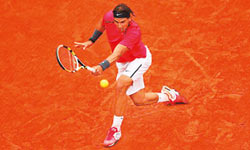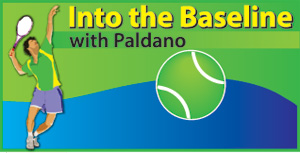Flair of addictive Red-Clay Tennis
France on the whole and Paris in particular did not have the best of times this year. The last week of May and the first week of June are changing the mood of the city and bringing back the mood of the well known musical track of ‘I love Paris every moment’. The French-Open on the eighteen red clay courts of the Roland-Garros Tennis complex is still in winter weather. The fans changed the mood into warm mornings. Red clay is the surface on which Tennis became popular in Continental Europe. It slows the game and extends the rallies keeping everyone in suspense. It is the best ‘opium’ of sports fans. Red Clay’s addictive effects are most on those who play the game as it hooks them to Tennis for life.
 Rain ravaged the opening two days and got the attention of the street entertainers performing within the Roland–Garros stadium. The reputed two courts are named after two French personalities – player administrator Philippe Chatrier and the legendary lady of French Tennis Suzanne Lenglen. Even in the cold, this atmosphere thrilled the fans who flocked into them. Paris, ‘the fashion capital of the world’ made Zebra-stripes the theme for 2016 Tennis outfits and both genders were sporting it. On red-clay courts the Stripes came alive. The well known French player Guy Forget is the current Director of the French Open.
Rain ravaged the opening two days and got the attention of the street entertainers performing within the Roland–Garros stadium. The reputed two courts are named after two French personalities – player administrator Philippe Chatrier and the legendary lady of French Tennis Suzanne Lenglen. Even in the cold, this atmosphere thrilled the fans who flocked into them. Paris, ‘the fashion capital of the world’ made Zebra-stripes the theme for 2016 Tennis outfits and both genders were sporting it. On red-clay courts the Stripes came alive. The well known French player Guy Forget is the current Director of the French Open.
Clay, cold and tough matches
In Grand-Slam events players are special and are kept in the main focus and their performances will fill reams in print now and in the years to come. French-Open is the second Grand-Slam of the year. In the first three days favourites were taken to testing limits where they barely survived and good many seeded players did not make it to the next round. Czech Republic’s Radek Stepanek, a known name coming back from sciatica back issue after many months nearly beat the ‘mighty Brit’ Andy Murray.
 The three hour forty one minute match was played was over two days. 7/5 in the third set says all about the tough match Murray managed to get through. At one point Stepanek was just two points short of sending Murray home. Then Murray faced French wild-card entry Marthias Bourgne and found himself once again down two sets to one. Murray had to play a total of ten sets to survive the first two rounds this year and that’s how tough Roland Garros can be to the best of players.
The three hour forty one minute match was played was over two days. 7/5 in the third set says all about the tough match Murray managed to get through. At one point Stepanek was just two points short of sending Murray home. Then Murray faced French wild-card entry Marthias Bourgne and found himself once again down two sets to one. Murray had to play a total of ten sets to survive the first two rounds this year and that’s how tough Roland Garros can be to the best of players.
32 Million Euro purse
Others on the winning streak in the first two rounds are the Williams sisters, Petra Kvitova, Simona Halep, Australia’s Samantha Stosur and Garbine Mugurusa – looking trim and fit with former Spanish Grand-Slam winner Conchita Martinez in her support team. Among the men are Stan Wawrinka, Nick Krygios with an umpires warning, Kei nishikori, Fernando Verdasco and Murray. Australian-Open winner Germany’s Kerber lost in her opening match and Victoria Azarenka former world’s number one’s injury which took her out of the last two events came up again and she conceded her match in the third set to Belgium’s Bertens. Another well known casualty was Jelena Jankovic. Looking at the outfits the players were wearing, it was certain that it was cold in Paris. Apart from the prestige of winning the French-Open the purse of 32 million Euros is a good reason to fight back even if players are freezing.
The fascinating clay
The clay courts of Roland-Garros produce the most exciting Tennis. If not for clay courts, I believe, Tennis would not have become a popular sport worldwide. The speed reduction effect of clay makes players to reach the ball somewhat easily and this in turn makes the rallies longer. It is easier to send the ball back in the same direction from which it came on clay and very difficult to change direction. The bounce reduces speed and changes the vertical and horizontal ball trajectory significantly. This forces players to sustain rallies longer and use safe targets than go for winners. In short, change in tactics is never easy on clay which makes winning more challenging. The end effect of this is that the long rallies are exciting to spectators. Almost every match had long rally testing players’ endurance mentally and physically. Some rallies topped as much as thirty four shots.
The channel-slam
While winning the four Grand-Slams as Rod Laver did in 1969 is becoming remote, the term ‘Channel Slam’ is being coined by the media referring to winning the French-Open and the Wimbledon titles. The two events played on either side of the English Channel are, one on clay and the other on grass – the original two surfaces of Tennis. Tennis popularity did wane with the advent of concrete hard court surfaces. With many giving up Tennis with the ill effects of concrete, popular venues are reverting back to grass and clay in Europe.
In terms of spectator interest in Roland-Garros, clay is providing the entire spectrum of tactics being displayed by players. Extreme fast courts make Tennis physical and less mental and tactical. The popularity of the French-Open should be a lesson to popularize Tennis world wide. The ‘French Flair’ could be enjoyed another week in the visual and print media. George Paldano, Former int. player; Accredited Coach of Germany; National, Davis-Cup, Federation Cup coach–. georgepaldano@yahoo.com


